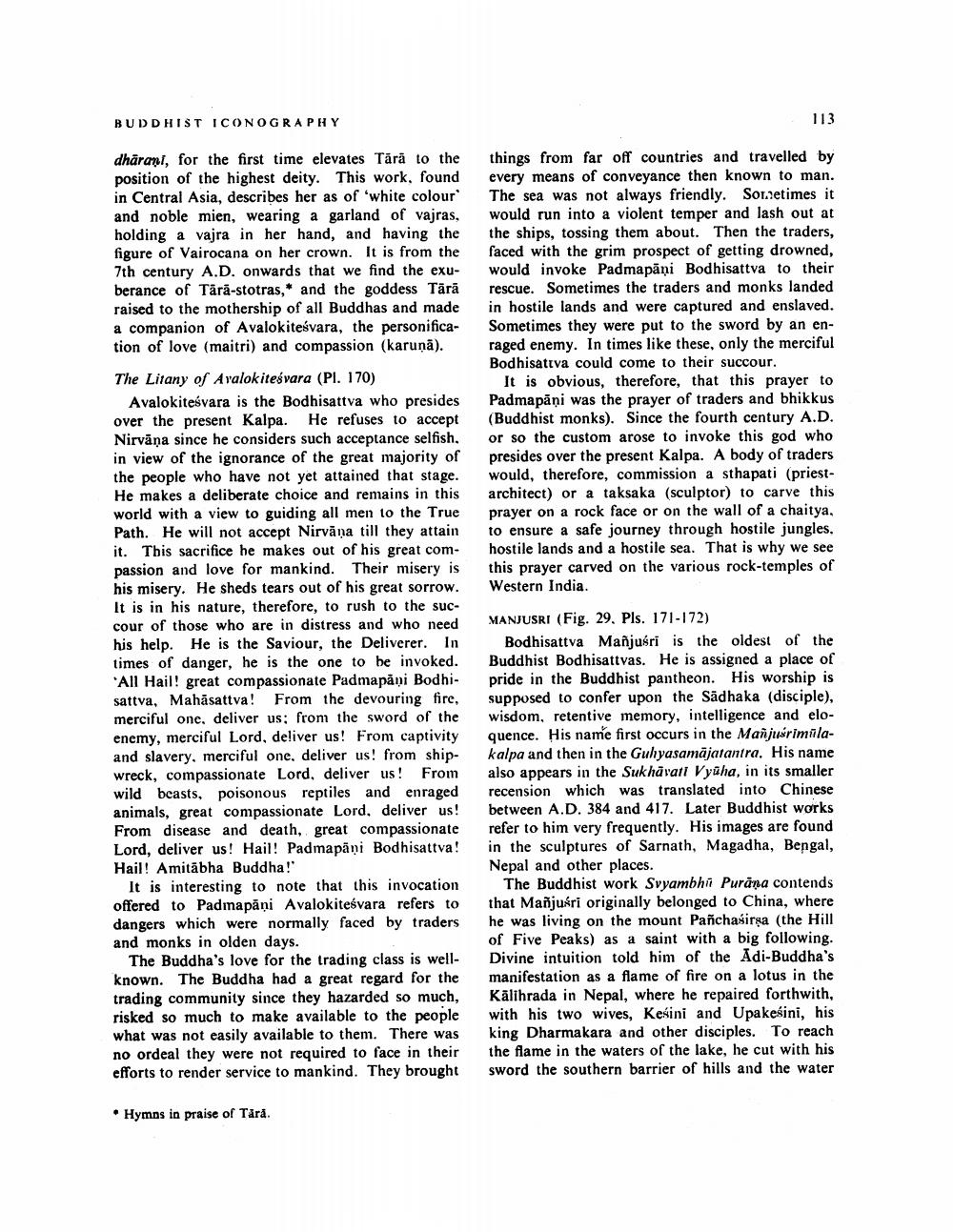________________
BUDDHIST ICONOGRAPHY
dharani, for the first time elevates Tără to the position of the highest deity. This work, found in Central Asia, describes her as of 'white colour' and noble mien, wearing a garland of vajras, holding a vajra in her hand, and having the figure of Vairocana on her crown. It is from the 7th century A.D. onwards that we find the exuberance of Tärä-stotras, and the goddess Tārā raised to the mothership of all Buddhas and made a companion of Avalokitesvara, the personification of love (maitri) and compassion (karuņā).
The Litany of Avalokitesvara (Pl. 170)
Avalokitesvara is the Bodhisattva who presides over the present Kalpa. He refuses to accept Nirvana since he considers such acceptance selfish. in view of the ignorance of the great majority of the people who have not yet attained that stage. He makes a deliberate choice and remains in this world with a view to guiding all men to the True Path. He will not accept Nirvana till they attain it. This sacrifice he makes out of his great compassion and love for mankind. Their misery is his misery. He sheds tears out of his great sorrow. It is in his nature, therefore, to rush to the succour of those who are in distress and who need his help. He is the Saviour, the Deliverer. In times of danger, he is the one to be invoked. All Hail! great compassionate Padmapāņi Bodhisattva, Mahāsattva! From the devouring fire, merciful one, deliver us; from the sword of the enemy, merciful Lord, deliver us! From captivity and slavery, merciful one, deliver us! from shipwreck, compassionate Lord, deliver us! From wild beasts, poisonous reptiles and enraged animals, great compassionate Lord, deliver us! From disease and death, great compassionate Lord, deliver us! Hail! Padmapāņi Bodhisattva! Hail! Amitabha Buddha!"
It is interesting to note that this invocation offered to Padmapāņi Avalokitesvara refers to dangers which were normally faced by traders and monks in olden days.
The Buddha's love for the trading class is wellknown. The Buddha had a great regard for the trading community since they hazarded so much, risked so much to make available to the people what was not easily available to them. There was no ordeal they were not required to face in their efforts to render service to mankind. They brought
⚫ Hymns in praise of Tără.
113
things from far off countries and travelled by every means of conveyance then known to man. The sea was not always friendly. Sometimes it would run into a violent temper and lash out at the ships, tossing them about. Then the traders, faced with the grim prospect of getting drowned, would invoke Padmapāņi Bodhisattva to their rescue. Sometimes the traders and monks landed in hostile lands and were captured and enslaved. Sometimes they were put to the sword by an enraged enemy. In times like these, only the merciful Bodhisattva could come to their succour.
It is obvious, therefore, that this prayer to Padmapāņi was the prayer of traders and bhikkus (Buddhist monks). Since the fourth century A.D. or so the custom arose to invoke this god who presides over the present Kalpa. A body of traders would, therefore, commission a sthapati (priestarchitect) or a taksaka (sculptor) to carve this prayer on a rock face or on the wall of a chaitya. to ensure a safe journey through hostile jungles, hostile lands and a hostile sea. That is why we see this prayer carved on the various rock-temples of Western India.
MANJUSRI (Fig. 29. Pls. 171-172)
Bodhisattva Mañjuśri is the oldest of the Buddhist Bodhisattvas. He is assigned a place of pride in the Buddhist pantheon. His worship is supposed to confer upon the Sadhaka (disciple), wisdom, retentive memory, intelligence and eloquence. His name first occurs in the Mañjurimilakalpa and then in the Guhyasamajatantra. His name also appears in the Sukhavati Vyuha, in its smaller recension which was translated into Chinese between A.D. 384 and 417. Later Buddhist works refer to him very frequently. His images are found in the sculptures of Sarnath, Magadha, Bengal, Nepal and other places.
The Buddhist work Svyambhi Purana contends that Mañjuśri originally belonged to China, where he was living on the mount Pañchasirṣa (the Hill of Five Peaks) as a saint with a big following. Divine intuition told him of the Adi-Buddha's manifestation as a flame of fire on a lotus in the Kālihrada in Nepal, where he repaired forthwith, with his two wives, Kesini and Upakeśini, his king Dharmakara and other disciples. To reach the flame in the waters of the lake, he cut with his sword the southern barrier of hills and the water




